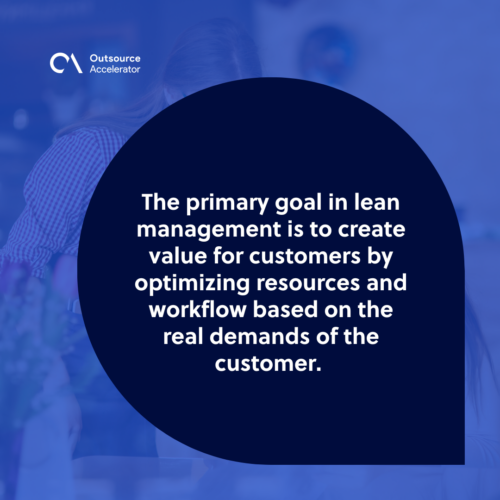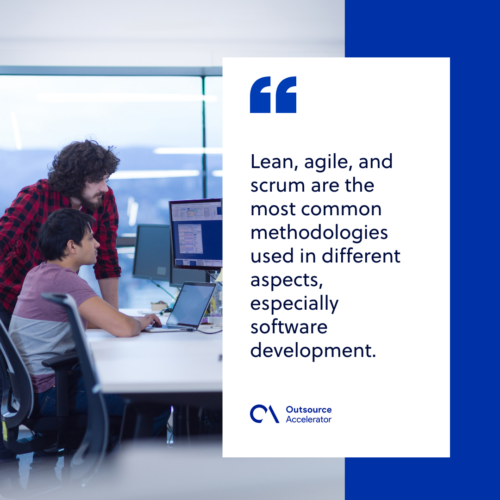A quick introduction to Lean Management and its uses

These days, global businesses have to continuously keep up with the demands of their customers to stay relevant. They have to keep tabs on every trend, on-demand product, and service that can make them stay with the company.
Some of them even take this to the next level, with customer-obsessed companies operating according to their clients’ needs.
To do this, you have to make sure that everything is in tip-top shape. Any blockages and hindrances in your processes can lead to longer downtimes and more dissatisfaction from clients.
Lean management has become popular in several industries seeking to prevent these roadblocks. Learn more about lean management and its benefits through this quick introduction.
What is lean management?
Lean management refers to a management approach that supports value flow in two guiding tenets: Continuous improvement and respect for people.
The concept was originated by Toyota in the late 1940s to remove waste and inefficiency in their manufacturing production. This is why lean management is also known as the Toyota Way.
Companies practicing lean management do not have a single leader holding total control of the company’s operations. Rather, leadership and responsibilities are shared within the entire organization.
The primary goal in lean management is to create value for customers by optimizing resources and workflow based on the real demands of the customer. It is said that lean can be tied to having a customer-centric approach in doing business for this matter.

The lean management principles
Toyota developed lean management practices through its five principles:
Value
Value refers to what the customers look for in a certain product. It determines the problem/s that a business tries to solve for its customers.
Everything that does not add to this value will be considered waste and should be removed.
Value stream
After determining the value, companies will look at the entire process of creating a product. Each aspect will be looked upon, from the raw materials used to its final delivery to customers. Customer support is usually included in the value stream.
Mapping the entire stream helps companies identify what part of the process does not add value to their services.
Flow
Once the waste is removed from the value stream, businesses have to make sure that the production flow runs smoothly.
Usually, developing and creating a product involves cross-functional teamwork. Developing flow means companies should check their entire production processes in several departments for possible bottlenecks and interruptions.
Pull
Companies improving production flow can see a gradual impact on their delivery of products and services. With this, they can establish their “pull” system or the process of making an item according to a customer’s needs and preferences.
By doing this, they get to save time, costs, space, and resources by not creating bulk orders without much demand.
Perfection
The last step is the most crucial aspect in making lean management happen: applying the entire lean thinking and improvement part of a company’s culture.
Lean management is not static; it requires constant effort and improvement to be perfect. Roadblocks may continue to show in a process depending on the team and their current equipment.
This is why continuous improvement is needed periodically.
Lean vs agile vs scrum: How to tell the difference
Lean, agile, and scrum are the most common methodologies used in different aspects, especially software development.
A team can work with either of the three methods. However, at times, some industries require companies to practice all of them for better management of a company’s projects.
Agile management is mainly focused on the continuous delivery of valuable output. It follows the Manifesto for Agile Development formed in 2001 and spread throughout several other areas of business.
In Agile, constant change gives organizations a competitive edge for their products.
Scrum management, meanwhile, is a subset of Agile and its most popular form of approach. Widely used by software developers, Scrum focuses on three main principles: team structuring, visualizing workflows, and iterative projects
Compared to the two, lean management focuses on reducing waste and risks while increasing customer value. It puts its emphasis on the system and does optimization from the top level down.

Examples of lean management use
Lean management is now seen in different forms and industries that could benefit the most.
Manufacturing
Lean manufacturing, known as lean production, is a method that aims to minimize waste and maximize productivity.
Lean is not limited to products and services. It even covers the processes, activities, and others that require time, money, and talent to invest in.
Some of the aspects prevented by lean manufacturing include:
- Inefficient and unnecessary processes
- Underutilized employees
- Unnecessary idle times, and
- Excessive inventories
Software development
In software development, lean helps to decrease programming effort and defects by at least one-third. Its purpose is to create more value with the software and make it more useful to its audience.
A subset of Agile, Lean software development modifies the landscape of quality monitoring in software systems.
It’s best to look for a software company, like Arcanys, that utilizes this technique as part of their processes.
Six sigma
Lean six sigma combines the concept of lean manufacturing and techniques used in six sigma in finding out what processes need to be improved and reduced.
Here, wastes in a process are reduced (lean) by using a systematic tool (six sigma) known as the DMAIC phases. DMAIC stands for:
- Define all information about the process;
- Measure the process’s capabilities;
- Analyze the data to identify the root cause;
- Improve by solving the root problem;
- Control and deploy the improved processes.
Startup
Lean startup is used to create a new company from an existing one. This usually solves the demand for a certain product that the existing company has or has yet to create and getting them into their customers faster.
Healthcare
Lastly, lean in value healthcare is the application of lean to improve patient satisfaction and reduce costs.
With this principle, all healthcare workers involved in an organization identify areas in processes that do not add value to patients and eliminate them.

How does lean management benefit companies
Lean management can help teams become more efficient at work. Not only that, it even contributes to the sustainability of a business. Here are some benefits that organizations can enjoy with lean.
- More efficient processes
- Increased productivity and reduced lead time
- Cost savings
- Increased company morale
- Sustained results without additional investment
- Eliminating overproduction
- Easier detection of defects
- More focus on equipment maintenance
What tools are used for lean management
Several tools are used by companies to reduce waste depending on their business nature and the strategies they need.
Below are some of the popular tools and techniques in lean management.
Bottleneck analysis
Bottleneck analysis looks at different areas of a process that cause the workflow to run slower than it should be. Visualized as a bottleneck, it helps identify the point of the blockage so teams can easily erase them.
Just-in-time method
Just-in-time (JIT) refers to a method in inventory where suppliers only send materials and products when needed. This decreases the tendency to, reduces holding costs, and increases turnover to customers.
Plan-do-check-act (PDCA)
Also known as the Deming cycle, plan-do-check-act (PDCA) is a simple scientific method used to manage changes in processes. PDCA involves four phases.
- Plan – Identify opportunities for improvement
- Do – Create a mock situation to try improvements
- Check – Analyze the mock results
- Act – Act based on the results
Poka-yoke
Poka-yoke or error-proofing is an analysis tool aiming to prevent errors or blockages. It makes sure a problem does not happen again by assuring the right conditions before a process occurs.







 Independent
Independent




